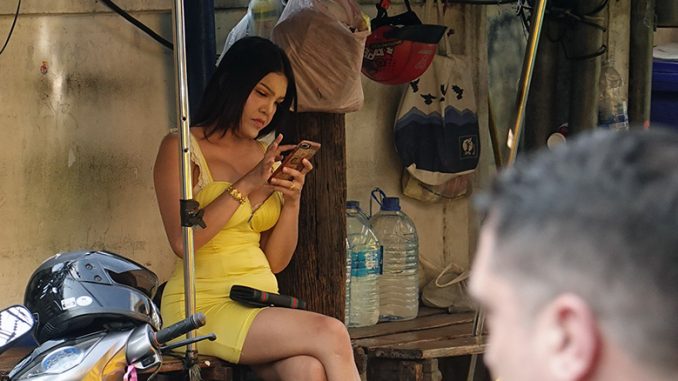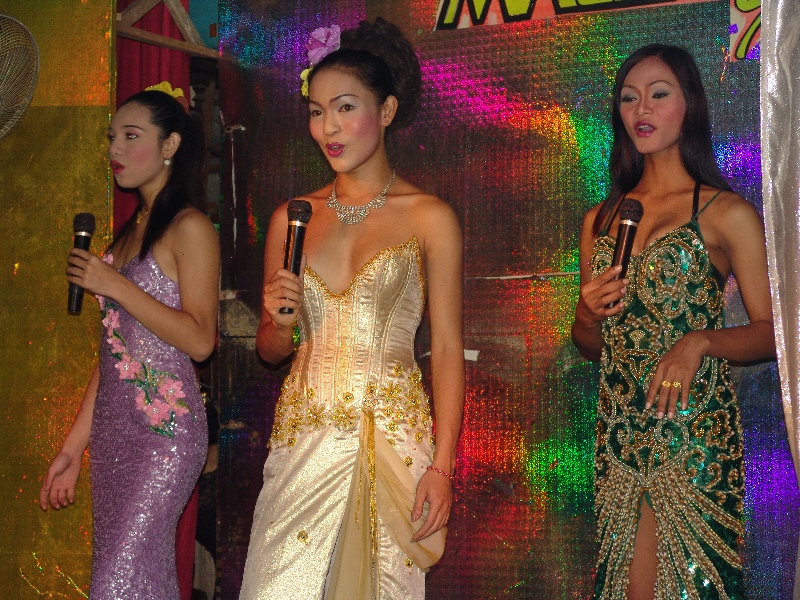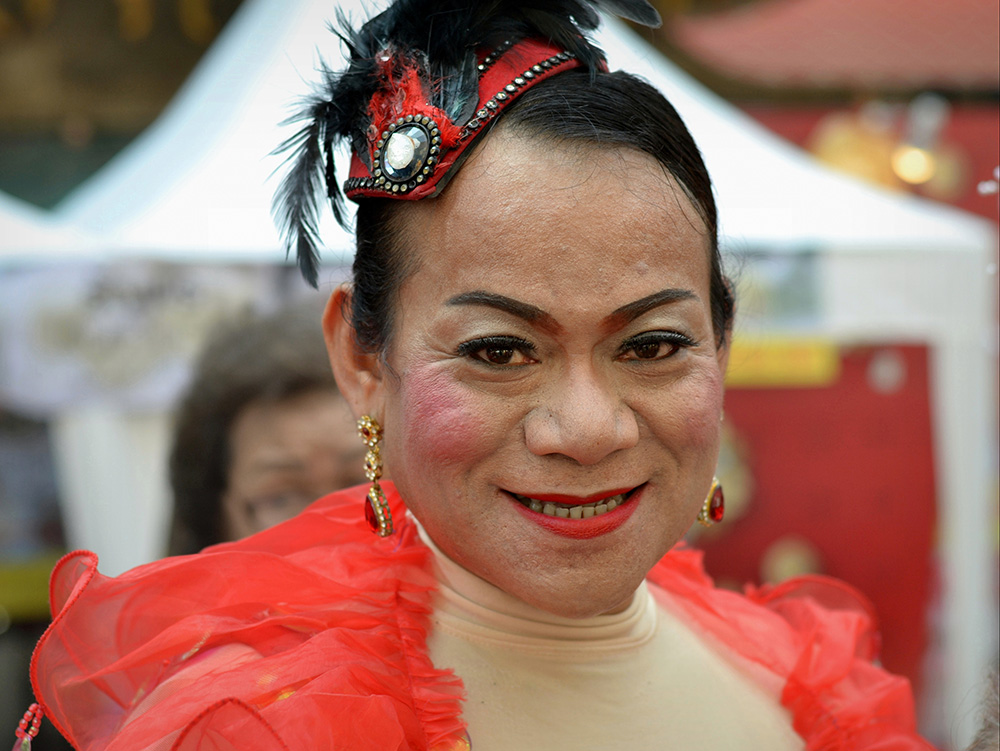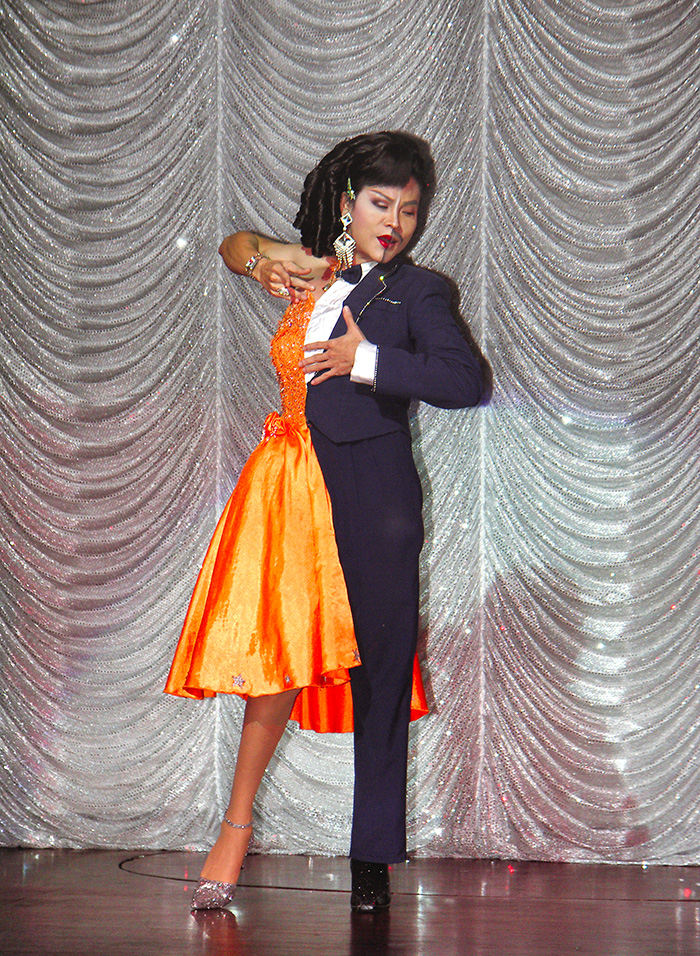
In this article, I assess the social situation of kathoeis (Thai transgender women), critiquing the development of society’s perspectives that reflect the stigmatization and discrimination that kathoeis face. Based on this critique, I make recommendations for the further study of kathoeis, using an analytic framework consisting of gender, sexuality, power, and marginality. While I review prior studies in this study, I present the topic through my personal experiences as a kathoei.
The findings show that the study of kathoeis must lie on a basis of understanding in what being a kathoei actually constitutes; in terms of our way of thinking, our way of life, adjustment skills and abilities, and our spritual side. This understanding affects the extent to which researchers understand the diversity of kathoeis. Issues that also need to be considered include cultural aspects of gender, the structure of oppression, societal power, societal violence, and pressure. These things, together with a lack of understanding in society, lead to a “re-invention of kathoei-ness” and the consequent marginalization of kathoeis. The study of kathoeis must involve gaining access to kathoeis’ experiences and perspectives and understanding them, which will lead to greater understanding. The methodologies to be used should critique the given knowledge/truths about kathoeis. Gaining access to kathoeis’ accounts is possible through various techniques, such as narrative methods, “telling our stories ourselves,” focus group discussions, participatory action research, and deep listening. As for increasing understanding, existing research is useful, addressing identities, agency, and diversity among kathoeis, as well as the impact of social class. Using these methods will enable researchers to portray kathoeis in a positive light, contribute to social change, and promote the rights of kathoeis.
Foreword
Kathoeis’ experiences have typically been recorded by those observing our experiences close by, or even through the voices of us kathoeis ourselves, and presented mostly in the form of research studies or online materials. Such accounts are all sources of knowledge about kathoeis. However, the social space of kathoeis is not particularly easily accessed, due to complexities in the origins of our identities, and due to the diversity of viewpoints that can be adopted about kathoeis. This has led kathoeis to become “people without societal opportunities” that are impoverished, confused, devoid of rights and without a way out. My lived experience and my understanding of other kathoeis’ experiences in various contexts have provided inspiration for this paper. I hope that the creation of this paper on methodological issues will help to create positive and comprehensive perspectives on kathoeis and on how Thai society relates to us. I hope the paper will incite critique and more vigor in the empowering study of kathoeis in the future.

Meaning and Connotations of the Word “Kathoei”
Reviewing the representations of kathoeis present in the media or people’s thoughts, one will discover a diversity of kathoeis in each context. The definitions given by both kathoeis and outsiders are thus also diverse. In my view, a kathoei is a person who wishes to change their sexual anatomy to adopt a gender opposite to that of their anatomical, in-born sex. Being a kathoei is a manifestation of sexual diversity. It is an attempt to not have the gender that society expects us to have; rather, we feel the need to live our lives according to a gender that fits our desires. Whatever definition one adopts, the most important thing is to not impose one’s definition on other kathoeis or other people, when those concerned do not wish to be thus defined. Issues of definition are sensitive since they affect the way we live our lives.
Even we kathoeis tend to appreciate diversity among us only to the extent that society spoonfeeds us. Society expects us to be all alike – funny, entertaining, devoid of substance, obsessed with sex, expert in sexual techniques, prone to lying, unable to meet true love, perverted, and so on. All these are societal prejudices, they are expectations of what a kathoei must be. And if a kathoei chooses to live her life in a way that differs from society’s expectations, she will be largely marginalized – or one might say, “be at the edge of the margin and about to fall off the page.” This in practice means being unemployed and not being able use one’s knowledge or skills, in contexts like the family, religions, education, welfare and so on. Kathoeis are agonized by this overload of prejudice in society. The above understanding is based on discussions with kathoeis and those working on our issues. I hope this paper will help to open up more space for the study of kathoeis and the societal contexts in which we live our lives, including issues like how we negotiate with society to create space for our identities, and how we try to manage the stigmatization and discrimination brought on us by the view that we are “abnormal.”

Basic Assumptions for the Study of Kathoeis
I view that understanding of diversity, whether in terms of social class, ethnicity, skin color, religion, or other facets, is very important for understanding everyone’s personal history. Researchers should make informed choices when selecting their data from the various strands of knowledge that exist on kathoeis, to best improve the social situation of those studied. Contemporary societal perceptions on masculinity and femininity are important to understand, as are society’s views on those who are not happy about having been assigned to either of the mainstream genders. Its time accept diversity in these domains.
Knowledge/Truth about Kathoeis
In attempting to bring social justice for kathoeis, searching for and reviewing existing knowledge/truths, as well as comparing them with new data from kathoeis and those closely following our experiences, is important for gaining a broad and understanding perspective on kathoeis.
1. Gender
Those members of Thai society that are diverse in terms of gender/sexuality have identities that are influenced by ideas relating to gender more than sexuality (Jackson, 2003) and the Thai lay understanding has divided people into three genders for quite some time. Adoption of sexological and psychoanalytic perspectives, and later, of information regarding people with sexual diversity from the Western world, has also constituted selective adaptation of only certain perspectives to supplement rather than supplant the preexisting Thai way of thinking about sex, gender and sexuality. The emergence of a wide array of new “genders” has further created confusion among lay people and academics alike, exacerbating the societal perception of kathoeis as unnatural and as contradicting society’s customs. Faced with this confusion about what they have viewed as “unclear genders”, Thais have sought explanations in religion and medical science alike, which both view that gender must be clearly assigned at birth with reference to one’s sexual organs, and that individuals need to follow that assignation in order to be normal (Sulaiporn, 2550, p.31). However, gender is socially constructed; therefore, “woman,” “man” and third or fourth genders (be they kathoei, taew, tut, taep, tom, dee, and so on) are all “genders” in the Thai sense, though only “man” and “woman” are viewed as fully normal and legitimate genders. Contemporary knowledge of sexuality confirms that gender is not fixed but fluid. A concrete example of this fluidity is sex reassignment surgery (SRS), but it also covers shifts in everyday gender presentation and sexual relations. This has led to the expression that some people need to do a “gender update” (Kritaya, 2551).
2. The Structure of the Oppression of Kathoeis
Kathoei identities begin at birth, from the person being assigned to a certain gender by medical institutions and professionals based on their sexual anatomy. The person being “a boy” or “a girl” is then recorded at the district office on their birth certificate and accompanied with naming the person with a name that can be identified as either “a man’s name” or “a woman’s name.” These practices by state administrative bodies create citizens divided into two categories, which is then reinforced by a normative consensus among institutions like the family, educational or religious institutions, and other groups of people. Therefore, for us kathoeis to accept “ourselves,” or to be an acceptable part of society, we need to construct a gender identity and modify our bodies to “pass” as complete women. We want to be women and believe this is based on the demands of our “true selves.” Since Thai society acknowledges only two legitimate genders, “man” and “woman,” and since we don’t feel we are “men,” it follows we must follow “women” as our role model. The term aep ying (“pretending to be a woman”) used by kathoeis reflects these practices – that is, kathoeis must know how to blend in, following societal rules, and this happens by using women’s practices as a point of reference. Women themselves are already subjected to a certain level of “compulsory gender sorting” by society’s heterosexist norms. However, the femininity of kathoeis involves various kinds of interpretations and definitions, and it cannot be represented by a straight line or various “stages” measuring our degree of femininity. It involves advancing and retracting, and it is not always “completed” through “sex change.” It depends on each kathoei’s perception of what is desirable and suitable, and what kinds of beliefs each of us holds on to femininity. But in any case, investment in femininity is very important for kathoeis attempting to gain social space in contemporary Thai society (Kittikorn, 2551).
3. Power/Pressure of Society’s Actions
Structural oppression in a patriarchal system involving the belief in only two legitimate genders affects the building of the sexual selves of kathoeis from an early age on. This leads to the underdevelopment of agency in kathoeis, as well as lack of negotiation power that would enable us to assert our space in society. Kathoeis are oppressed by the mainstream genders. Our lifestyles are deeply affected by the powerful voices of consumerist and medical discourses in today’s globalized world, which we have passively accepted given our ingrained sense of weakness. Kathoeis also face structural oppression from various powerful societal institutions, sometimes aware of being oppressed, sometimes not, but nevertheless usually forced to accept what is taking place in the oppressive society we live in – whether in the fields of employment, education, religion, in public health services, or other areas. Often, kathoeis are made to feel weak and inferior. Understanding implicit power is thus important as it leads to a broader understanding of kathoeis (Ouyporn, 2553).

The Societal Re-Invention of Kathoeiness
Kathoeis who express their identity clearly, or visibly modify their bodies, tend to face rejection from society, which directly affects kathoei individuals, communities, and the society in which kathoeis live. Such problems directly affect kathoei individuals both physically and psychologically, as well as through discrimination in employment and through not receiving equal protection from society, on par with men and women (Sitthiphan, Ronnapoom & Pimpawun, 2551, p. 14). These kinds of actions reflect a lack of respect for human dignity as well as lack of respect for the principle that all human beings should be able to live their lives in society on an equal basis, without discrimination and feelings of inferiority.
The division of humanity into two binary opposite categories (men and women) might result in kathoeis not passing as either or lose societal acceptance as a result. This constitutes judging people based on their looks, rather than accepting that kathoeis are valuable, have human dignity and are members of their society (Krittayachon, 2552, p. 27-28). In a Thai-style society and culture, the importance of societal rules, or of what is called kala-thetsa (lit., “time and place,” i.e., situational propriety) cannot be overlooked, as these things greatly affect self-awareness, openness about one’s identity, and bodily transitioning, with age and geographic location also playing a part. For example, many kathoeis cannot be open about their identities when at home with their parents but choose to be open about their identities at school or university. It can be considered a manifestation of agency if we kathoeis know when we need to use either masculine or feminine role models in various situations, places positions, and ages. These factors and cultural contexts impose various conditions and societal regulations on kathoeis and thereby affect our gender identities and sexualities (Sitthiphan, Ronnapoom & Pimpawun, 2551, p. 21). Kathoeis will strive to “come out of the closet” and adopt a feminine identity as soon as these factors and contexts permit.
Methodological Practices: Gaining Access, Understanding
The attempt to understand individuals and societies simultaneously also constitutes an attempt to understand their interrelations – individuals are a part of their context, and societies are constituted through the actions of several individuals. Our life histories and what are societally hot topics in each era affect the way we focus on and understand various societal phenomena. Thus, in the study of kathoeis, appropriate methodologies are needed methodologies that appreciate the humanity and complexity of kathoeis and are gender sensitive.
I view that kathoeis’ own experiences are important and that they should be told, listened to, studied, and understood from a context-specific perspective. What one kathoei has been subjected to or encountered constitutes the reality of that person, be it rape, physical violence, discrimination or whatever. Researchers should listen to the realities and experiences of kathoeis rather than expect kathoeis to confirm or reject their own theories. Collaboration between researchers and their kathoei research participants are important both during the creation of new understandings and when ways are devised to communicate those understandings to others. The research of Costa & Matzner (2007), who invited kathoeis to write their own autobiographies and then had these published in full, with these two authors’ own analysis at the end of the book is a good example of such collaborative research.
Methodologies for Accessing Kathoeis’ Accounts
Since kathoeis are the most visible of all of Thailand’s non-mainstream “genders,” identifying kathoeis while looking for research participants might not be particularly difficult. However, to get kathoeis to reveal personal life experiences might require some trust building, expression of friendliness, and appreciation of kathoeis as people facing oppression and discrimination from society. The kinds of suffering kathoeis must face are naturally diverse, with factors such as the identity, the family, communities, and society playing a role, and also affecting the degree to which kathoeis are able to be open about their identity. Gaining access to the stories of kathoeis thus requires a diversity of techniques. I feel that the following are interesting options.
Narrative research (Kittipat, 2552) is informed by feminist methodologies and consists of processes that open space for the transmission of life experiences in a sophisticated way. Its important principle is focusing on life experiences. As we have seen, the life experiences of kathoeis consist of being marginalized, being denied rights, opportunities, and social space. Kathoeis have plenty of stories waiting to be told, but we usually lack a listening ear. Our stories are thus typically excluded and ignored. Using narrative methods enables expression of life experiences.
Telling Our Stories Ourselves (TOSO) and Focus Group Discussion (FGD) (Chai, 2550) facilitate the emergence of natural conversation, exchange of views and group dynamics beneficial for harnessing the group’s power in analyzing an issue together. These methods enable kathoeis to tell our stories together either with other kathoeis or other sexually diverse groups, with a clearly defined goal to gain correct and relevant information.
Participatory Action Research (PAR) is a method that can create collaborative processes of learning, produce shared understandings, liberate kathoeis of the fetters of suffering, enable us to come together as a group, partnership, or alliance, and collaborate to create awareness of selected phenomena in society and the world. It seeks knowledge and resources that kathoeis already have, to solve identified problems, viewing kathoeis as “co-creators of knowledge” rather than as “informants.”
Deep listening is a method proposed by Oyuporn (2553) to increase the value of the spoken accounts of kathoeis. It is participatory learning combining experiential-based learning and mind-based learning, toward the goals of self-transformation and societal change. It works through empowering participants to find their inner strength and to value and respect other participants while they are speaking. Especially for marginalized groups whom nobody listens to, this method helps instill trust, build relationships, encourage the use of shared power and of confidential, unprejudiced listening.

Understanding Kathoeis
Building understanding on kathoeis might happen using secondary sources, such as news reports, which not only reflect what is taking place at a given time, but also how those reporting view the phenomenon. At the same time, biased reporting causes kathoeis to lack space, our sexualities made into a taboo, and accurate knowledge on us to be in short supply. When there is a lack of clarity on kathoei-related issues, kathoeis are left without social space and face the choice between adopting the identity of “a man” or “a woman,” but since passing as either may not be possible, discrimination ensues. When we speak of kathoeis, our lifestyles and sexualities, are researchers speaking of kathoeis or are kathoeis speaking of themselves? Which meanings are used and what is their significance for the study? Sitthiphan, Ronnapoom & Pimpawun (2551) have made the following four conclusions on aspects that should be focused on when researching kathoeis.
(1) Kathoei identities. The extent to which we kathoeis can express and change our identities depends on the context – whether it is private or public, urban, or rural, because different contexts differ in terms of the intensity of societal control, surveillance, and their divisiveness based on various misconceptions prevalent in each context. Specific geographic areas conducive for kathoei self-expression do exist, such as Bangkok and Pattaya. (2) Kathoei agency. Kathoeis that have high access to resources such as prestigious employment will help boost their agency and social space. (3) Diversity of kathoeis. The complex and diverse sexualities of kathoeis obviously affect our sexual health both directly and indirectly. Understanding the issues involved is not easy, since sexualities are subjective and exist in private spaces. However, understanding sexuality can help us avoid judgmental attitudes and stereotyping of kathoei selves, behaviors, and our complex and diverse sexualities. (4) Social class and kathoeis. While kathoeis in all areas and social classes face health problems related to shifting identity, social class modifies the extent to which kathoeis face rights violations and issues.
Benefits of the Study of Kathoeis
The hegemony of science-influenced beliefs on kathoeis as abnormal greatly and unjustly affect the way kathoei individuals and communities are treated, and what kinds of services are arranged for us. However, beliefs associated with medical science cannot fully explain people’s identities. Thus, throughout the world there are people demanding that transgender identities be seen as normal, hoping that such a perception will lead to social change and empowerment of transgendered people. As a part of this, it is necessary to collect data with appropriate methodologies to build appropriate attitudes and practices, and harmonious coexistence in society at large.
The benefit for both kathoeis and others that is to be expected from the study of kathoeis is a greater understanding of the context in which kathoeis live their lives, of developments in the perception that kathoeis are abnormal or suffer from “gender identity disorder,” as well as elucidation of the ways in which kathoeis assert their space and take issue with the invisible power of various discourses and beliefs. The study of kathoeis also informs the creation of recommendations for creating better relations between kathoeis and others, for the provision of various kinds of welfare, and for designing policies that respect the rights and identities of kathoeis.
Conclusion
The contribution this paper makes to the study of kathoeis might consist primarily of recommendations on how to gain data from, or in collaboration with, kathoeis. These recommendations involve basic assumptions on how to create appropriate lenses for viewing kathoeis, for all those interested and for kathoeis willing to revisit their own similar experiences. With a firm conviction in developing human potential, one will surely also believe in the possibility of the creation of space for the study of kathoeis as well. In preparation for that, collating existing knowledge from prior research on kathoeis can provide helpful basic assumptions and viewpoints for learning more about the way of life of kathoeis. Or at least, if readers simply understand kathoeis better through reading this paper, I already feel I have achieved one goal. The kinds of tasks that await us now are building databases that collate existing knowledge, further critique of the ways in which knowledge of kathoeis in various contexts can be created to build more credible argumentation, as well as helping kathoeis to have self-awareness, courage, and enabling society to view “kathoei-ness” with pride.
Kath Khangpiboon
Department of Social Work Faculty of Social Administration, Thammasat University Bangkok, Thailand
Banner Image: Bangkok, Thailand: Transgender woman, kathoei, sitting on bench and using her phone. Man on foreground watching her. JRJfin, Shutterstock
Bibliography
Apinya Fuengfusakul (อภิญญา เฟื่องฟูสกุล). (2546/2003). อัตลักษณ์ (Identity). Bangkok, Thailand:Office of the National Research Council.
Chai Podhisita [ชาย โพธิสิตา]. (2550/2007). ศาสตร์และศิลป์แห่งการวิจัยเชิงคุณภาพ [The art and science of qualitative research]. Bangkok, Thailand: Amarin Printing and Publishing.
Chalidaporn Songsamphan (ชลิดาภรณ์ ส่งสัมพันธ์). (2551/2008, March). เพศวิถี: นิยามความหมาย และพัฒนาการกรอบแนวคิด (Sexuality: Definitions and developments in the framework). Positive Youth Development seminar, Bangkok.
Costa, L. M., & Matzner, A. L. (2007). Male bodies, women’s souls: Personal narratives of Thailand’s transgendered youth. Binghamton, NY: Haworth
Kittikorn Sankatiprapa [กิตติกร สันคติประภา]. (2550/2007). การลวนลามทางเพศกะเทย : นัยสำคัญภายใต้
วาทกรรมรักต่างเพศ [Kathoey sexual harassment: Its significance in heterosexual discourse]. Unpublished doctoral dissertation, Srinakharinwirot University, Bangkok, Thailand.
Kittipat Nonthapatamadul [กิติพัฒน์ นนทปัทมะดุลย์]. (2552/2009). ทักษะการบำบัดแนวเรื่องเล่าและทักษะการวิจัยแนวเรื่องเล่า : ทักษะสองด้านในเนื้อเดียวกัน [Narrative therapy and narrative research: Two sides of the same skill]. Bangkok, Thailand: Phrik Wan Graphic.
Kritaya Archavanitkul & Kanokwan Tharawan [กฤตยา อาชวนิจกุล และ กนกวรรณ ธราวรรณ]. (2550/2007). วิเคราะห์วิธีวิทยาในงานวิจัยเรื่องเพศภาวะและเพศวิถีกับเอดส์ศึกษา [Analyzing [วิธีวิทยา] in studies on gender, sexuality and AIDS]. Bangkok: Edison Press Products.
Kritaya Archavanitkul [กฤตยา อาชวนิจกุล]. (2551/2008). ฤา ปฏิบัติการของสังคมไทยในกระแสจารีตเรื่องเพศจะอ่อนกำลังลง? [Or are the conservative practices of Thai society on sexual matters becoming weaker?]. In Thawatchai Phachun & Pimpawun Boonmongkol [ธวัชชัย พาชื่น และพิมพวัลยบุญมงคล] (Eds.), รายงานการประชุมประจําปีเพศวิถีศึกษาในสังคมไทย คร้งที่ 1 หัวข้อ: วิพากษ์องค์ความรู้และธรรมเนียมปฏิบัติเรื่องเพศวิถีศึกษาในสังคมไทย [Proceedings of the First Annual Sexuality Studies in Thai Society Conference: Critiquing the body of knowledge and practices of sexuality studies in Thai society] (pp. 57-72). Nakhon Pathom, Thailand: Secretariat of the
1st Annual Sexuality Studies in Thai Society Conference, Center for Health Policy Studies, Faculty of Social Sciences and Humanities, Mahidol University.
Krittayachon Sukyaroke (กฤษฏยชนม์ สุขยะฤกษ์). (2552/2009). นักศึกษาเพศที่สามใมหาวิทยาลัย
ธรรมศาสตร์:การดำเนินชีวิตและสวัสดิการ (Transgender students at Thammasat University: Lifestyle and welfare). Unpublished master’s thesis, Thammasat University, Bangkok, Thailand.
Monruedee Laphimon, Pimpawun Boonmongkon, Sarinya Singthongwan, Urairat Nayai & Ronnapoom Samakkeekarom (มลฤดี ลาพิมล, พิมพวัลย์ บุญมงคล, ศรินยา สิงห์ทองวรรณ, อุไรรัตน์ หน้าใหญ่, รณภูมิ สามัคคีคารมย์) (2551/2008). วาทกรรมเรื่องเพศในหลักสูตรเพศศึกษา แนวใหม่ : มุมมอง การต่อรอง และการประยุกต์ใช้ (Sexual discourses in contemporary sex education: Perspectives, negotiation and application). Bangkok, Thailand: Women’s Health Advocacy Foundation.
Ouyporn Khuankaew (อวยพร เขื่อนแก้ว). (2553/2009, January). การอบรมการสร้างผู้นำและการ เปลี่ยนแปลง (Training on building leaders and social change). Mae Rim, Chiang Mai, Thailand.
Prempreeda Pramoj na Ayutthaya (เปรมปรีดา ปราโมช ณ อยุธยา). (2546/2003). การช่วงชิงอัต ลักษณ์ “กะเทย”ในงานคาบาเรต์โชว์ (Contesting identities of “Kathoei” in cabaret show). Unpublished master’s thesis, Chiang Mai University, Thailand.
Sitthiphan Boonyapisomparn, Ronnapoom Samakkeekarom & Pimpawun Boonmongkon [สิทธิพันธ์ บุญญาภิสมภาร, รณภูมิ สามัคคีคารมย์ & พิมพวัลย์ บุญมงคล]. (2551/2008). ชีวิต ตัวตน และเรื่องเพศของสาวประเภทสอง [Life, identity and sexual matters of sao praphet song]. Bangkok, Thailand: Women’s Health Advocacy Foundation.
Sulaiporn Chonwilai [สุไลพร ชนวิไล]. (Ed.). (2550/2007). เพศไม่นิ่ง – ตัวตน เพศภาวะ เพศวิถี ในมิติสุขภาพ [Shifting sex—Identity, gender and sexuality within a health perspective]. Salaya, Nakhon Pathom, Thailand: The Southeast Asian Consortium on Gender, Sexuality and Health.
Watcharin Noosomton [วัชรินทร์ หนูสมตน]. (2546/2003). ชีวิตและการทำงานของสาวประเภทสอง [Life and work of the male transgenders]. Unpublished master’s thesis, Thammasat University, Bangkok, Thailand.
